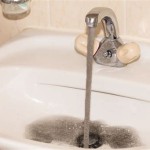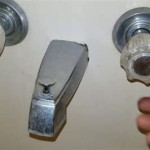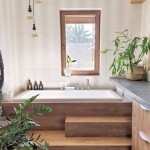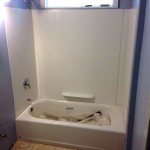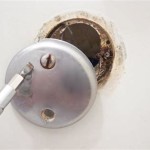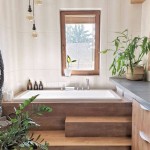How a Bathtub Overflow Plate Works: Diagrams and Explanation
The bathtub overflow plate is a seemingly simple, yet crucial component of a standard bathtub drain system. Its primary function is to prevent water from overflowing the tub edges, potentially causing water damage to surrounding areas. This mechanism works through a combination of physical barriers, water level detection, and a drain pathway connected to the main drainpipe. Understanding the intricacies of how a bathtub overflow plate works requires examining its components, its connection to the drain, and the variety of designs employed.
The overflow plate is typically a circular or rectangular plate made of metal or plastic, mounted near the top of the bathtub, typically just below the rim. It often includes a lever or knob for controlling the drain stopper, but the overflow function itself is independent of the stopper control mechanism, though often integrated within the same overall assembly. Behind the visible plate lies a more complex system involving a vertical pipe or channel that links the overflow opening to the main drainpipe. This hidden aspect is the core of the overflow's functionality.
The purpose of this article is to provide a detailed explanation of the components and operation of a bathtub overflow plate. It will also explore the different types of overflow systems available and offer visual diagrams for improved understanding.
Key Components of a Bathtub Overflow System
The bathtub overflow system is comprised of several essential parts that work together to prevent flooding. These components include the overflow plate, the overflow pipe, the linkage mechanism (if present), and the connection to the drainpipe. Dissecting each component allows for a better understanding of the system's overall function.
1. Overflow Plate: This is the visible element usually attached to the bathtub near the top. It houses the overflow opening, which is essentially an inlet for excess water. The plate is secured to the tub wall using screws or bolts and often has a decorative finish to match the bathtub fixtures. Besides visual appeal, the plate’s design may also influence the flow rate of water entering the overflow pipe. Newer designs incorporate easier access for cleaning out debris.
2. Overflow Pipe: Located behind the bathtub wall, the overflow pipe is a vertical channel that connects the overflow opening on the plate to the main drainpipe. This pipe is typically made of PVC, ABS, or metal, depending on the bathtub's plumbing system. Its diameter is designed to handle a substantial flow of water, ensuring efficient drainage during an overflow event. The pipe's length varies depending on the tub’s height and the location of the drainpipe. A properly sealed connection between the overflow pipe and the drainpipe is crucial to prevent leaks.
3. Linkage Mechanism (If Applicable): Many bathtub overflow systems integrate the overflow plate with the drain stopper mechanism. In such configurations, a linkage mechanism connects the lever or knob on the overflow plate to the stopper in the drain. When the lever is moved, it lifts or lowers the stopper, controlling whether the bathtub holds water or drains. This linkage can involve rods, pivots, and springs, all designed to provide smooth and reliable operation. The linkage should also be adjustable to ensure proper stopper seating and sealing. Proper maintenance of the linkage is crucial to prevent leaks and ensure efficient drainage.
4. Drainpipe Connection: At the bottom of the overflow pipe, a connection is made to the main drainpipe. This connection is typically achieved using a T-fitting or a similar plumbing connector that allows water from both the bathtub drain and the overflow pipe to flow into the main drainpipe. This connection must be watertight to prevent leaks and ensure proper wastewater disposal. The fitting type and connection method (e.g., solvent welding, threaded connections) will depend on the piping material and local plumbing codes.
The interplay of these components defines the efficiency and reliability of the bathtub overflow system. Proper installation and maintenance are crucial to ensure that the system functions correctly and prevents water damage.
Operational Principles of a Bathtub Overflow Plate
The fundamental principle behind a bathtub overflow plate is simple: when the water level in the bathtub reaches the overflow opening, excess water flows into the overflow pipe and is directed to the drainpipe. However, the specifics of how this process operates can vary depending on the design and features of the overflow system. The following sections outline the key operational aspects of a typical bathtub overflow plate.
1. Water Level Detection: The overflow opening on the plate acts as a water level sensor. Once the water level rises to the bottom edge of the opening, water begins to enter the overflow pipe. The size and shape of the opening influence the rate at which water can enter the pipe, and thus, the effectiveness of the overflow system in preventing floods. Larger openings allow for a faster drainage rate.
2. Gravity-Driven Drainage: The overflow pipe leverages gravity to move the water from the overflow opening down to the drainpipe. The vertical orientation of the pipe ensures that water flows downwards due to gravity. The smooth interior surface of the pipe reduces friction and facilitates efficient drainage. The height difference between the overflow opening and the drainpipe connection creates the necessary pressure head for gravity-driven flow.
3. Drainpipe Integration: The overflow pipe is connected to the main drainpipe, allowing the overflowing water to mix with the water draining from the bathtub's primary drain. The design of the connection point ensures that the overflowing water does not impede the flow of water from the main drain and vice versa. Proper venting of the drainpipe is also important to prevent siphoning and ensure smooth drainage from both the bathtub and the overflow system.
4. Air Entrapment Prevention: Some overflow systems incorporate design features to minimize air entrapment within the overflow pipe. Trapped air can impede the flow of water and reduce the effectiveness of the overflow system. These features may include angled pipe connections or air vents that allow air to escape from the overflow pipe.
5. Stopper Control Integration: As mentioned previously, many overflow systems are integrated with the drain stopper mechanism. The lever or knob on the overflow plate controls the position of the stopper, allowing the user to either fill the bathtub or drain the water. The linkage between the lever and the stopper must be properly adjusted to ensure that the stopper seals tightly and prevents leaks when the bathtub is being filled. This integration simplifies the control of both the overflow and the drain functions. However, it also introduces a point of potential failure if the linkage mechanism becomes damaged or misaligned.
Understanding these operational principles provides a comprehensive view of how a bathtub overflow plate functions to protect against water damage. The system operates passively, relying only on gravity and the water level to trigger the drainage process. Regular maintenance and inspection are essential to ensure that the system continues to function effectively over time.
Diagrams and Types of Bathtub Overflow Systems
Visual aids, like diagrams, are invaluable for grasping the inner workings of bathtub overflow systems. These diagrams illustrate the connections between components and highlight the flow of water during an overflow event. Furthermore, various types of overflow systems exist, each with unique designs and features. Understanding these variations can aid in troubleshooting and selecting the appropriate system for a particular bathtub.
Diagrammatic Representation: A typical bathtub overflow system diagram will show the overflow plate attached to the tub wall, with the overflow opening clearly visible. Behind the wall, the diagram illustrates the vertical overflow pipe connecting the opening to the main drainpipe. The diagram will also depict the linkage mechanism (if present) that connects the overflow plate lever to the drain stopper. Arrows indicate the direction of water flow during an overflow event, showing how excess water enters the overflow opening, travels down the overflow pipe, and joins the water flowing from the bathtub drain into the main drainpipe. The diagram often includes labels identifying each component of the system, such as the overflow plate, overflow pipe, linkage mechanism, drain stopper, and drainpipe connection.
Types of Overflow Systems: While the basic principle remains the same, bathtub overflow systems come in different designs to suit various bathtub styles and plumbing configurations. Some common types include:
1. Trip Lever Overflow: This is the most common type, featuring a lever on the overflow plate that controls the drain stopper. The lever is connected to the stopper via a linkage mechanism. Moving the lever up or down opens or closes the stopper, respectively. The overflow function operates independently of the lever position.
2. Lift-and-Turn Overflow: This system uses a knob on the overflow plate that, when lifted and turned, opens or closes the drain stopper. The knob is directly connected to the stopper via a threaded rod or similar mechanism. Again, the overflow function is separate from the stopper control.
3. Push-Button Overflow: A push-button mechanism on the overflow plate controls the drain stopper. Pushing the button once seals the drain, while pushing it again releases the stopper. This type often has a more streamlined appearance.
4. Cable-Operated Overflow: This system uses a cable instead of a rigid linkage to connect the overflow plate lever to the drain stopper. This design allows for more flexibility in installation and can be useful in situations where space is limited. The cable is typically enclosed in a protective sheath to prevent damage and ensure smooth operation.
5. Toe-Touch Overflow: In this design, the drain stopper is operated by pressing it with one's toe. The overflow plate has no lever or knob for stopper control. This simpler design is often favored for its ease of use.
Understanding the different types of overflow systems is crucial for choosing a suitable replacement or troubleshooting issues. Each type has its own advantages and disadvantages in terms of ease of installation, maintenance, and aesthetics.
In summary, a bathtub overflow plate is a carefully engineered safety mechanism that prevents water from overflowing. It operates based on water accumulation, gravity, and a connection to the drainpipe. Knowing the various components and type of overflow systems will help keep your bathroom safe.

Drain Overflow Assemblies Fine Homebuilding

What Is A Bathtub Overflow Drain 2025 Guide With Examples And Photos Badeloft

7 Bathtub Plumbing Installation Drain Diagrams

7 Bathtub Plumbing Installation Drain Diagrams

Bath Waste Overflow Guide 101 Size Materials And Finish Hofen Drain

Bathroom Fixtures How Do You Turn The Overfow Drain In Tub Upside Down Home Improvement Stack Exchange

How To Size A Tub Drain

What Is A Bathtub Overflow Drain Does All Tubs Have

7 Bathtub Plumbing Installation Drain Diagrams

How To Fix A Leaking Bathtub Overflow Drain Diy Guide
Related Posts

